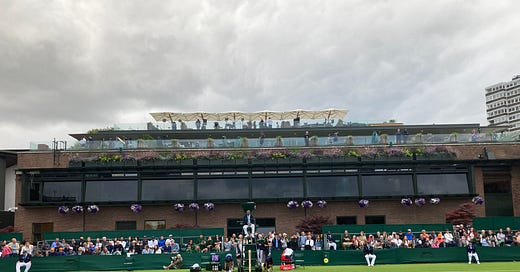Wimbledon uncovered #2: "The fix is in. Get to court No.14 to watch it"
This is a story about a professional player who threw a match at Wimbledon, then got busted for drugs, several times, and lied about everything he did.
It’s a peculiar feeling to go to watch a top-class sporting event knowing for certain that the match you’re about to watch is going to be fixed in front of your eyes, with someone involved corruptly making financial gain.
This has only happened to me once, but it happened at Wimbledon - where I am as I write this - during the Championships in a men’s singles match. It turned into a really strange day, interviewing the player at the heart of the fix immediately afterwards and then speaking to his bewildered opponent.
But there was no swift resolution or conclusion to the case, even though I wrote about the dodgy match on the back page of the next day’s newspaper, including the detail that a formal investigation was underway.
I was highly suspicious of the player as I spoke to him, not least because I’d watched him hit a series of highly amateurish, even slapstick, strokes as he tanked the third set.
I met a couple of middle-aged ladies who were also watching him. I got talking to them and they were compatriots and didn’t know him, but they had spent the previous evening in the same pub he was in.
This didn’t strike me as particularly professional by the player, but, I thought, it takes all sorts.
It was about six months later that other pieces of the player’s wider cheating conduct started to fall into place, although that involved drugs, not fixing.
And it was fully 18 months before I’d put the whole story together, but before I tell you about that, let’s go back in time to the late Noughties, when tennis had a serious match-fixing problem, and not only infrequently in minor events by obscure players, which remains the case today.
In early 2009 I started to look at tennis integrity, and match-fixing in particular, in a much deeper way than I’d done before. This followed a series of tip-offs about players ranked inside the top 100, and came about 18 months after the infamous match between Nikolay Davydenko and Martin Vassallo Arguello in Sopot, Poland in August 2007.
Betfair had taken the unprecedented step of voiding bets on that match after $7m was matched, most on Arguello to win, even after Davydenko won the first set. Davydenko subsequently withdrew injured. A lengthy investigation by the tennis authorities ended without sufficient evidence to prosecute anyone for wrong-doing after that investigation was deliberately stymied.
To be more precise, various people close to Davydenko had declined to give investigators access to their mobile phone records, and the phone companies had a time limit on when they would or could release those records. Basically those involved deliberately hampered the investigation.
I was given access to some of the investigators who had worked on the case, and was shown a room where the walls were full of charts showing who had wagered what on that match and when, and more charts that detailed phone calls between various parties involved.
There were elements of organised crime involved, and bets placed in Russia primarily, but also Italy. But the investigation had no jurisdiction over those places, and the lack of phone records linked to Davydenko meant it could never go anywhere.
There were a number of players under investigation for (probably) unrelated fixing and over a period of several months I spoke to bookmakers, investigators, players, administrators and gamblers, past and present, to establish the extent of tennis’s illegal gambling problem, what had been done to combat it, and what was planned for the future.
The ‘tennis family’ of the ITF, ATP and WTA had already published an ‘Environmental Review of Integrity in Professional Tennis’ in May 2008. This 66-page document was put together by the seasoned sports integrity experts Ben Gunn and Jeff Rees. The full document in PDF format can be downloaded here: Integrity in tennis.
That review looked at 73 matches that had seen suspicious betting in the previous five years and as Gunn and Rees wrote on page 1 of the executive summary of their review: “Patterns of suspected betting activity have been noted on 27 accounts in two different countries and there are emerging concerns about some players which would warrant further attention.
“Bearing in mind these matches only relate to Betfair account holders, it is reasonable to assume that other suspect betting is taking place using other international legal and illegal betting markets. So there is no room for complacency.”
Following my work in early 2009, prior to Wimbledon that year, The Independent ran a number of related articles, including ‘Wimbledon on high alert over suspected match-fixing rings’, and ‘How tennis failed to act in vital betting test case’.
Over many weeks I’d been in close contact with professional gamblers and market monitors. Which is how, one morning, I got a call from a contact who told me a fix was on, today, at Wimbledon. “The markets are wild,” he said. “Get out to court 14.”
This piece is the second in a four-part series about Wimbledon. Yesterday’s piece included the 10 secrets of Wimbledon’s success as the best organised and most democratic tournament in sport. Tomorrow we’ll have a definitive breakdown of who ranks as the all-time best of the best in SW19 (Wednesday), and then on Thursday the revealing findings of what you, the readers, consider the greatest ever matches at Wimbledon. Read more about that, and how to have your say, here.
But back to the wild markets and the exhortation to get to Court No.14.
I did. And it all happened in front of me.




